Focus of the Issue
Kazakhstan’s Petroleum Refining and Gas Chemical Project Overview
Vyacheslav Li, Deputy General Director, Chief Engineer of KGNT,
Sergey Donskov, Deputy Chief Engineer for oil refining and petrochemistry of KGNT,
Assel Aimbekova, technology department engineer of KGNT
At the end of 2009, the Kazakhstan’s Government on the basis of industrial plans of the Map of Industrial development has established the Program of Accelerated Industrial and Innovative development of the Republic of Kazakhstan 2014, which has become one of the most important elements of the economic policy of the new decade. Several projects are being implemented within the program:
- modernization of the Atyrau oil refinery;
- modernization of the Shymkent oil refinery;
- modernization of Pavlodar oil refinery;
- construction of integrated gas chemical complex on the territory of the FEZ National Industrial Petrochemical Technology Park.
KGNT, as the leading engineering company of the Republic of Kazakhstan in industrial design, project management, engineering, and adaptation of international projects to the existing legal framework of the Republic of Kazakhstan, took an active part in implementation of the oil refineries modernization projects development program and carried out the following works and services:
- at the Atyrau refinery: adaptation of feasibility study of the aromatic hydrocarbons production center, advanced oil processing center, work projects for tank batteries construction, heat of turbine units, drainage and pumping lines, receivers of compressors, commercial metering stations, construction of intraplant gas pipeline, indoor input ventilation in PTS, etc.;
- at the Shymkent oil refinery: adaptation of the feasibility study and project for modernization and reconstruction of the Shymkent oil refinery, sulfur recovery units, isomerization units, working draft for construction of an automatic on-spot plant;
- at the Pavlodar refinery: adaptation of Feasibility Study and an upgrade project of the Pavlodar refinery (early phase 1), intake and storage complex for 2 million tonnes of crude oil and gas oil a year, a working draft of a commissioning and start-up complex for two stand-up reservoirs-20000 sq. m. to receive Kazakhstan’s oil.
At present, the company is carrying out field supervision of construction of the advanced oil processing center at the Atyrau refinery, isomerization plant with a crude oil preliminary hydrotreating unit at the Shymkent oil refinery, and other projects in oil and gas production and processing.
The end of modernization contributes to stabilization of the domestic fuel market, which saw some problems in 2014. Initially, completion of modernization was planned in 2016, but the timing of the project had been postponed in connection with adopting EurAsEC Technical Regulations. Therefore, to create a world-class oil refining industry, ensure the energy security of Kazakhstan in the manufacturing sector, and meet the country’s demand for basic petroleum products, there are the following fundamental objectives:
- Increase in oil processing up to 18-19 million tonnes per a year (restoration of the Shymkent oil refinery capacity up to 6 million tonnes/year, increase in capacity of the Pavlodar refinery up to 7 million tonnes/year);
- Enhancing oil refining efficiency up to minimum of 85;
- Increase in output of light oil products, control of existing shortage in high-octane gasoline, aircraft fuel;
- The maximum increase in product range;
- Making the quality of motor fuels consistent with the requirements of the EurAsEC Technical Regulations of the Customs Union Commission, K-4; 5 emission standards.
- Compliance with the modern requirements on industrial and occupational safety in accordance with existing rules and regulations of the Republic of Kazakhstan;
- Compliance with the modern requirements on environmental protection in accordance with existing rules and regulations of the Republic of Kazakhstan;
- Сompliance with the modern requirements on resource conservation and energy saving in accordance with existing rules and regulations of the Republic of Kazakhstan;
To solve these problems, the Oil-Refining Industry Development Programme is established, which is long-term and involves four-stages implementation from 2008 to 2017.
1. Atyrau refinery upgrade project
Today, the rated capacity of the Atyrau oil refinery is 5 million tonnes/year, but the plant’s actual capacity is below the nominal one, of vacuum gas oil conversion is not performed, it is sold as raw semi-finished product. The total oil refining efficiency is about 56%. The raw material is a mixture of 80% of Mangyshlak and 20% of Tengiz crude oils.
The upgrade project of the Atyrau refinery provides:
1) modernization of the CDU / VDU-3 vacuum distillation unit and modernization of a delayed coking unit;
The upgrade will ensure:
- to increase vacuum gas oil output;
- to increase residue conversion at an average of 300 thousand tonnes annually with a supplementary yield of light fuels;
- to increase oil refining efficiency;
- to substantially improve environmental performance.
2) construction of an Aromatics Production Centre (APC);
A new benzol & paraxylol production center and paraxylene will receive raw materials from the new continuous catalytic reformer with discharge capacity of heavy naphtha of 1 million tonnes/year.
3) construction of the advanced oil processing centre (AOPC).
The AOPC is designed for processing of vacuum gas oil, heavy coker gas oil and not minimum of 40% residual bottoms after atmospheric distillation. The designed fresh feed rate of the main unit of will be about 2.23 million tonnes/year. The advanced oil processing center is integrated with the existing units and new approved projects (catalytic reforming unit and Morphylane unit of the APC). The residue fluid catalytic cracker will become the heart of the AOPC, it will turn poor-cracking stock with high coking efficiency and high in metals content into precious hydrocarbons in the form of unsaturated gas, gasoline and light gas oil.
Processing the mixture of unsaturated liquefied gases C3 and C4 catalytic cracker will be resulted in output of high-octane oligomeric compound (polymer-gasoline), which is a component of commercial gasoline. Processing the light fraction of catalytically cracked gasoline and methyl alcohol will result in output of high-octane tertiary amyl methyl ether (TAME), which is a valuable additive to increase gasoline octane number. The bulk of the intermediate fraction of catalytically cracked gasoline is hydrotreated, then the hydrogenation product will meet the requirements for catalytic reforming unit raw materials and will provide it and, consequently, the APC, with 100% process utilization rate. The rest of the intermediate and all heavy part of gasoline are high-octane components of commercial gasolines. To raise the octane number of gasoline, light straight-run naphtha and catalytically cracked gasoline will be isomerizated.
Also, to control shortage of low sulfur aircraft fuel, straight-run and re-refined kerosene cuts are subject to selective hydrogenation and treating. Straight middle distillates in the blend with middle distillates of catalytic cracking, delayed coking are hydrotreated with output of a component of commercial summer diesel fuel that complies with the K-4,5 requirements. Involvement of straight-run vacuum residues to the composition of catalytic cracking vacuum distillates feed, will significantly reduce production of fuel oil and put the company at the up-to-date level of both product quality and oil refining efficiency.
Construction of new and modernization of old plants will increase the oil refining efficiency up to 86% and receive additional quantities of gasoline and aviation kerosene consistent with K4,5 standards, while maintaining the rated capacity of the Atyrau oil refinery, and ensure 100% raw material input in the APC. It is expected that the Atyrau oil refinery will process the 5,000 thousand tonnes/year of oil producing 4,372 thousand tonnes/year of petroleum products, the output increase will be 822 thousand tonnes/year of petroleum products.
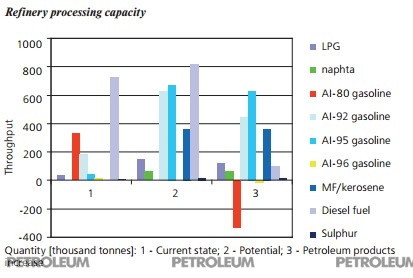 Refinery processing capacity
Refinery processing capacity
2. Shymkent oil refinery modernization (upgrade) project
Initially, the Shymkent oil refinery was constructed with the passport capacity of 6.0 million tonnes/year for processing West Siberian low-viscosity oil. The current operating capacity of the refinery amounts to 5.2 million tonnes/year of high-paraffin Kumkol crude oil. The flow diagram of the upgraded refinery is modelled in such a way as to be able to vary several blended crudes from 100% Kumkol oil to blend composition: 50 wt% of Western Siberian crude oil, 25% of Kumkol crude oil, and 25% of crude oil from Aktobe region fields.
In order to achieve the goals and objectives, the project include:
1) upgrade of existing distillate hydrotreating unit and crude unit with a view to improve the quality of diesel fuel, and reduce the sulphur content to less than 10 parts per million and achieving the capacity of 6 million tonnes/year;
2) construction of new residual cracking unit to obtain additional quantity of light hydrocarbons, straight-run gasoline and catalytically cracked gasoline hydro-treating and isomerization to comply with K-4,5 emission class in terms of content of impurities and octane number, production of MTBE (methyl tertiary-butyl ether) to replace tetraethyl lead, the previously used additives to increase octane number of gasolines in Kazakhstan; production of sulfur, etc.
Construction of new and modernization of existing processing units in 2 stages:
1st stage. The following plants are designed and their construction has been began:
- The construction of isomerization unit with upgrading naphtha pre-hydrotreating unit.
- Single point loading.
- Claus sulfur plant with capacity of 4.0 million tonnes per a year.
- 4. Upgrade of the distillate hydrotreating unit.
2nd stage. Other processing units provided by the project.
Output after the upgrade in case of processing 6.12 million tons of oil annually is shown in the chart:
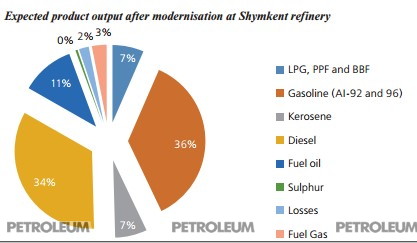 Expected product output after modernisation at Shymkent refinery
Expected product output after modernisation at Shymkent refinery
The modernization results in greatly increased output of light products (from 70% to 89%) and oil refining efficiency - from 70% to 93% with drastic reduction of residuals production and cancellation of vacuum gas oil release.
3. The Pavlodar petrochemical plant an upgrade project
To date, the maximum producing capacity is 4.5 mln tonnes of crude oil per a year with a designed capacity of 6 mln tonnes. The refinery 100% works with West Siberian oil. The oil refining efficiency is approximately 65%. The enterprise produces such oil-products as motor gasoline, kerosene, diesel fuel, heating oil, fuel oil, bitumen, liquefied gas, sulfur, coke and others. The largest share in the structure of manufactured products falls on gasoline - 23%, diesel - 28.8% and heating oil - 15% (as of 2013).
The project objectives:
- to provide possibility of processing Kazakhstan’s oil (a mixture of 50% Kumkol and 50% Aktobe oil);
- to increase the refinery capacity up to 7 million tonnes of West Siberian oil per a year with the possibility of processing Kazakhstan’s oil to the equivalent of about 5.2 million tonnes per year.
Technical upgrade of the refinery is done by dividing the project implementation into construction commissioning and start-up complexes. The first construction commissioning and start-up complex will ensure production of isomerized product - a high-octane component of commercial gasoline, for the subsequent release of K4 class gasoline. The second construction commissioning and start-up complex will provide the West Siberian oil refining in the amount of 6 million tonnes per a year and production of gasoline and (summer) K4 class diesel fuel. The third construction commissioning and start-up complex will provide the West Siberian oil refining in the amount of 7 million tonnes per a year and processing of about 5.2 million tonnes Kazakhstan’s oil per a year, production of K5 class gasoline and summer/winter diesel fuel.
Output after the upgrade of the Pavlodar oil chemistry refinery in case of processing 5.2 million tonnes of Kazakhstan’s oil per a year is shown on the chart:
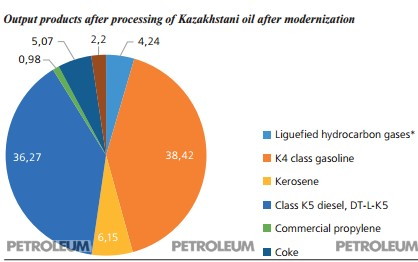 Output products after processing of Kazakhstani oil after modernization
Output products after processing of Kazakhstani oil after modernizationTechnological upgrade of the Pavlodar oil chemistry refinery will increase the output of light oil products (gasoline - to 38.42%, kerosene - to 6.15%), increase the octane number of gasoline by means of the isomerization unit, to improve fuel quality bringing up to K-4, 5 standard, through hydro treating plants, increase the refinery capacity in terms of the West Siberian oil, and possibility of processing of Kazakhstan’s oil is provided.
4. Integrated gas chemical complex construction project
Within the scope of accelerated industrial and innovative development of the country the project Integrated Gas Chemical Complex Construction is being implemented in Atyrau region in the territory of the FEZ National Industrial Petrochemical Technology Park.
The project is implemented by phases:
Phase 1. Polypropylene production with capacity of 500 tonnes per a year.
Phase 2. Polyethylene production with capacity of 800 tonnes per a year.
Phase 1 Main refinery process units include:
- propylene production unit with capacity of 503,000 tonnes/year;
- polypropylene production unit, polymerization and extrusion block with capacity of 500,000 tonnes/year.
The main raw material for production of commercial products is propane, ethylene, the products are homopolymers and copolymers of propylene. The main feed gas is to be supplied through the main gas pipeline from Tengiz field, and liquefied propane is to be shipped by rail from Tengiz and Kashagan fields.
Phase-2 Integrated gas chemical complex construction project is also construction of a new petrochemical plant. The entire project consists of reprocessing facilities located in two sites (Tengiz and Karabatan) located in approximately 200 km from each other and ethane gas pipeline connecting the sites.
The construction objects of this project include:
- Polyethylene production plant with infrastructure at Karabatan;
- Gas fractionating plant (GFP) in and around Tengiz;
- Ethane transportation gas-main pipeline;
- Feed gas supply pipeline with the TCO to GFP, dry gas return pipeline with GFP to TCO – GEEP pipeline.
Production technology is polyethylene output (the final product) using dry gas from the Tengiz field (feedstock). In GFP methane, ethane, propane and butane are extracted. Ethane and heavier fractions are extracted from the feed gas, while the rest of the feed gas (export gas) is supplied to the existing pipeline of the Capacity Expansion Project for the gas shipment (GEEP) in order to further use by consumers. For more extensive gas purification in GFP it is carried out mercury extraction, gas dehydration at condensation point of -40оС, and removal of COS and mercaptans remains (originally the feed gas is treated at TCO).
Gas fractionating plant near TCO provides extraction from the supplied TCO feed gas of 630 million m3/year (at 1 atm. and 20°C), extraction of ethane (833 thousand t/year), propane (400 thousand t/year) and butane (50 thousand t/year) with return of dry gas to TCO.
The extracted ethane is supplied through the main ethane pipeline to the polyethylene producing plant at Karabatan. The extracted propane and butane will be pumped through the pipeline to tank car loading rack, and then be directed to polypropylene production (Figure 1).
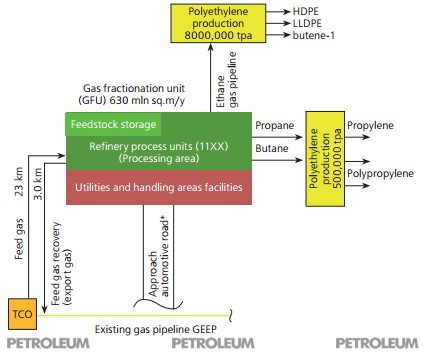 Kazakhstan’s Petroleum Refining and Gas Chemical Project Overview
Kazakhstan’s Petroleum Refining and Gas Chemical Project Overview
Ethan is then supplied through pumps to the gas-main pipeline. Gas pipeline scheme consists of two gas-main pipelines D40” (DN 1,000 mm) called the dry gas and feed (shipped) gas pipelines. As a border of the gas pipelines chart the following is accepted:
- Dry gas pipeline is the main gas pipeline output from TCO to the receiving station located on the site of GFP with a length of 23 km;
- The raw gas pipeline (to be shipped) from the GFU outlet site to the export gas pipeline tie-in (GEEP), with length about 3.0 km.
The polyethylene plant will receive the full product line of linear low density polyethylene (LLDPE), medium density polyethylene (MDPE) and high density polyethylene (HDPE) from 0.910 to 0.965 g/cm3.
In general, the implementation of these projects is a new step in the development of Kazakhstan's oil and gas processing industry. KGNT and other projects are aimed at the systematic implementation of the relevant activities.
This January ENGINEERING COMPANY KAZGIPRONEFTETRANS (KGNT) organized the International Practical Conference- Integration of Modern Technological Developments and Standards In the Oil&Gas Industry with the official support from the Ministry of Energy of the Republic of Kazakhstan, NC KazMunaiGas JSC and KAZENERGY Association. The Conference facilitated the exchange of experience and ensured the introduction of new technologies and equipment, advanced techniques and experience of technical regulation in order to further promote the integration of modern technological developments and standards in the oil and gas industry to improve the efficiency, safety and competitiveness. The Conference was attended by 150 delegates from the State authorities, public organizations and mass media, petroleum and service companies from 17 countries of the world: Kazakhstan, Russia, Ukraine, the United Kingdom, the United States, France, Japan, Germany, Italy, the Netherlands, Austria, Norway, Czech Republic, Denmark, Lithuania, China and Argentina. The Conference provided speaking opportunities for 28 participants. Upon opening ceremony of the Conference, the Director of the Association KAZENERGY Aset Magauov awarded the KGNT Managing Director Gennady A.Tarassov with the medal for his personal contribution to the development of the petroleum industry and in the honour of his 60th anniversary.
Published the full text of the article




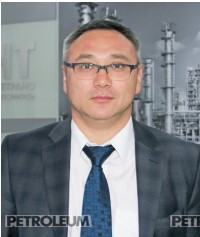 Vyacheslav Li
Vyacheslav Li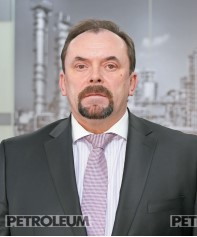 Sergey Donskov
Sergey Donskov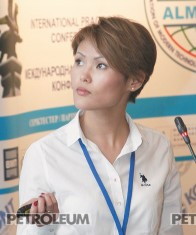 Assel Aimbekova
Assel Aimbekova